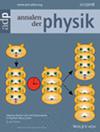粒子理论的代数路线图
IF 2.5
4区 物理与天体物理
Q2 PHYSICS, MULTIDISCIPLINARY
引用次数: 0
摘要
扩展了先前的研究结果,证明了六种已知粒子理论之间的代数连接网络。这些是自旋模型,乔治-格拉肖模型,帕蒂-萨拉姆模型,左右对称模型,希格斯机制前后的标准模型。与标准模型相比,网络中新包含的四元数反射进一步区分了W±$W^{\pm}$玻色子和z0 $Z^0$玻色子。它可能为电弱对称性破缺的现象学引入微妙的新考虑。本文章由计算机程序翻译,如有差异,请以英文原文为准。

An Algebraic Roadmap of Particle Theories
Expanding the results of previous research, a network of algebraic connections is demonstrated between six well-known particle theories. These are the Spin(10) model, the Georgi–Glashow model, the Pati–Salam model, the Left–Right Symmetric model, the Standard Model both pre- and post-Higgs mechanism. A new inclusion of a quaternionic reflection within the network further differentiates bosons from the boson in comparison to the Standard Model. It may introduce subtle new considerations for the phenomenology of electroweak symmetry breaking.
求助全文
通过发布文献求助,成功后即可免费获取论文全文。
去求助
来源期刊

Annalen der Physik
物理-物理:综合
CiteScore
4.50
自引率
8.30%
发文量
202
审稿时长
3 months
期刊介绍:
Annalen der Physik (AdP) is one of the world''s most renowned physics journals with an over 225 years'' tradition of excellence. Based on the fame of seminal papers by Einstein, Planck and many others, the journal is now tuned towards today''s most exciting findings including the annual Nobel Lectures. AdP comprises all areas of physics, with particular emphasis on important, significant and highly relevant results. Topics range from fundamental research to forefront applications including dynamic and interdisciplinary fields. The journal covers theory, simulation and experiment, e.g., but not exclusively, in condensed matter, quantum physics, photonics, materials physics, high energy, gravitation and astrophysics. It welcomes Rapid Research Letters, Original Papers, Review and Feature Articles.
 求助内容:
求助内容: 应助结果提醒方式:
应助结果提醒方式:


